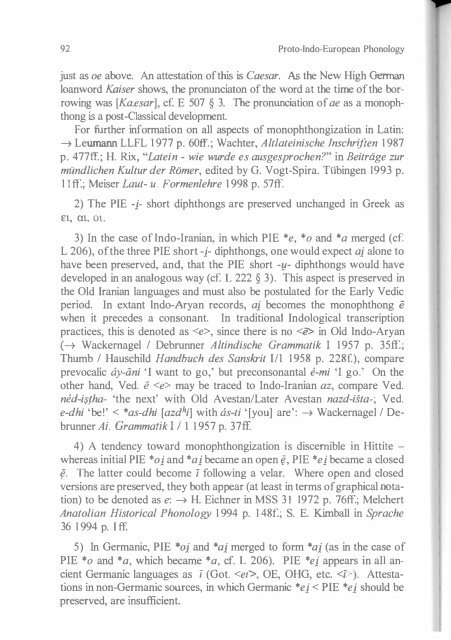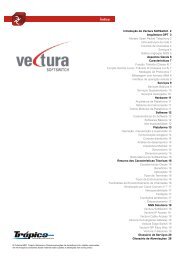Create successful ePaper yourself
Turn your PDF publications into a flip-book with our unique Google optimized e-Paper software.
92 Proto-Indo-European Phonologyjust as oe above. An attestation <strong>of</strong> this is Caesar. As the New High Germanloanword Kaiser shows, the pronunciaton <strong>of</strong> the word at the time <strong>of</strong> the borrowingwas [Ka.esar], cf. E 507 § 3. "The pronWlCiation <strong>of</strong> ae as a monophthongis a post -Classical development.For further information on all aspects <strong>of</strong> monophthongization in Latin:-7 Leumann LLFL 1977 p. 60ff.; Wachter, Altlateinische lnschriften 1987p. 477ff.; H. Rix, "Late in - wie wurde es ausgesprochen?" in Beitrage zurmiindlichen Kultur der Ramer, edited by G. Vogt-Spira. Tiibingen 1993 p.I1 ff.; Meiser Laut- u. Formenlehre 1998 p. 57ff.2) The PIE -j- short diphthongs are preserved unchanged in Greek asEl, al, ot.3) In the case <strong>of</strong> lndo-Iranian, in which PIE *e, *0 and *a merged (cf.L 206), <strong>of</strong> the three PIE short -j- diphthongs, one would expect aj alone tohave been preserved, and, that the PIE short -l!- diphthongs would havedeveloped in an analogous way (cf. L 222 § 3). This aspect is preserved inthe Old Iranian languages and must also be postulated for the Early Vedicperiod. In extant lndo-Aryan records, aj becomes the monophthong ifwhen it precedes a consonant. In traditional Indological transcriptionpractices, this is denoted as «t>, since there is no «t> in Old lndo-Aryan(-7 Wackemagel / Debrunner Altindische Grammatik I 1957 p. 35ff.;Thumb / Hauschild Handbuch des Sanskrit III 1958 p. 228f.), compareprevocalic ay-ani 'I want to go,' but preconsonantal e-mi 'I go.' On theother hand, Ved. if «t> may be traced to Indo-Iranian az, compare Ved.nM-i$lha- 'the next' with Old AvestanlLater Avestan nazd-ista-; Ved.e-dhi 'be!' < *as-dhi [azdhi] with as-ti '[you] are': -7 Wackemagel / DebrunnerAi. Grammatik l J I 1957 p. 37ff.4) A tendency toward monophthongization is discernible in Hittite _whereas initial PIE *oj and *aj became an open , PIE *ej became a closed. The latter could become i following a velar. Where open and closedversions are preserved, they both appear (at least in terms <strong>of</strong> graphical notation)to be denoted as e: -7 H. Eichner in MSS 31 1972 p. 76ff.; MelchertAnatolian Historical Phonology 1994 p. 148f.; S. E. Kimball in Sprache36 1994 p. I ff.5) In Germanic, PIE *oj and *aj merged to form *aj (as in the case <strong>of</strong>PIE *0 and *a, which became *a, cf. L 206). PIE *ej appears in all ancientGermanic languages as i (Got. «tl>, OE, OHG, etc. Classical Lat. deus / divus, cf. L 217 § 3), Ved. devam,Lith. dievas m 'god,' ON tiv-ar nom plural 'gods.' For more informationon this subject, cf. W 202 § 2. - PIE *dejli- 'to point, indicate' (For examples<strong>of</strong> zero grade PIE *dili-, see ahove L 211 § I.) = Lat. dicere 'to announce,determine, speak' (ex-deic-endum is preserved in Old Latin), Gr. 8ei1cV1l!ll 'Ishow,' Ved. deM- m 'area' « *'direction'), Got. ga-teihan 'to report, proclaim,'OHG zihan = NHG zeihen. - PIE *i!'ej-m- 'winter' = Gr. XEllla n.'winter (storm),' Ved. he-man loc. sg. 'in the winter,' Hitt. gimmant- (-7Melchert Anatolian Historical Phonology 1994 p. 102, p. 145), Lith. iie-maf., OCS zi-ma f. 'winter.'2) Correspondence sets for PIE *oj: - PIE *(H)6j-no- 'one' = OLoino(m) m 'the one (acc.)' (Classical unus), Gr. 01VT] f. 'one (as on a die)' (-7Chantraine DELG S. v.), Got. ains 'one,' Old Prussian ains 'alone, only,' cf. F502 § I. - PIE *lojkW-o- 'remaining, left over' (with -0- ablaut, changes toPIE *lejkW-, Gr. Ael= etc.) = Gr. A.ol1l6 OHG lifhan 'fief.' - Also compare PIE *!!6jlio- and"l!ojde in L 217 § 1.3) Correspondence sets for "aj: - PIE *Iajl!o- 'left' = Gr. A.al Lat. lae\IUS, OCS lev. 'left.' - PIE "kajka- 'blind (in one eye)' = Lat. caecus 'blind,'Got. haihs 'one-eyed.' - For information on problems concerning Protoludo-Europeana, cf. L 211 § 5.L 222. The fate <strong>of</strong> short -l!- diphthongs in the lE languages:I) "The Proto-Indo-European short -l!- diphthongs *el!, *oy and *ay, whichare analog to the short -j- diphthongs are preserved in Greek as £u ou, and QU.2) While is preserved in Latin until the classical period, PIE "el! and" Ol! are already unified as *Ol! in Proto-ltalian; it has been suggested that isolatedattestations <strong>of</strong> OL correspond to e!! (compare Leucesie, attested in aCarmen Saliare): -7 Leumann LLFL 1977 p. 71; Meiser Laut- u. Formenle-





